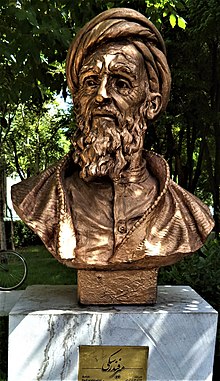Mir Fendereski
Mir Fendereski | |
|---|---|
میرفِنْدِرِسْکی | |
 Bust of Mir Fendereski in Isfahan province | |
| Born | 1562 |
| Died | 1563 |
| Occupation | Philosopher & Poet |
| Known for | Writing various works such as: Resâle Sanaie Resâleh dar kimiyâ Šahre ketabe mahârat |
Mir Fendereski (Persian: میرفِنْدِرِسْکی) (1562–1640) was a Persian[1] philosopher, poet and mystic of the Safavid era. His full name is given as Mir Abulqasim Mirfendereski (Persian: میرابوالقاسم میرفندرسکی), and he is famously known as MirFendereski. He lived for a while in Isfahan at the same time as Mir Damad, spent a great part of his life in India among yogis and Zoroastrians, and learnt from them. He was patronized by both the Safavid and Mughal courts.[2] The famous Persian philosopher Mulla Sadra also studied under him.[3]
Life
Mir Fendereski remains a mysterious and enigmatic figure about whom we know very little.[2] He was probably born around 1562-1563 and died age of eighty.[2]He gained a reputation of asceticism at the court of Shah Abbas, Isfahan. He is said to have journeyed throughout India, following which he became a vegetarian and refused to go on pilgrimage to Mecca, lest he should be forced to sacrifice sheep. [4]
Mir Fendereski was trained in the works of Avicenna as he taught the Avicennian medical and philosophical compendiums of al-Qanun (The Canon) and Al-Shifa (The Cure) in Isfahan.
Works
This section needs expansion. You can help by adding to it. (June 2008) |
A number of works are attributed to him, although these have not been studied in detail. In his extensive commentary on the Persian translation of the Mahabharata (Razm-Nama in Persian) and Nizam al-Din Panipati's rendition of the Yoga Vasistha, he complains about the quality of the translation, which implies that he was familiar with Sanskrit. He was among a group of Persians at the Mughal court to engage with Indian thought.
Some of his most famous works are "Resâle Sanaie", "Resâleh dar kimiyâ" and "Šahre ketabe mahârat", in Persian language. He was also a poet and composed a long philosophical ode (qaṣida ḥekmiya) in imitation of and response to the Persian Ismaʿili thinker Nasir Khusraw. His best-known work is titled al-Resāla al-ṣenāʿiya, an examination of the arts and professions within an ideal society. The importance of this treatise is that it combines a number of genres and subject areas: political and ethical thought, mirrors for princes, metaphysics, and the critical subject of the classifications of the sciences.[2]
See also
Notes
- ^ Hossein, Nasr, Seyyed. "Findiriskī". Encyclopedia of Islam, second edition, Brill. Retrieved 11 February 2017.
{{cite web}}: CS1 maint: multiple names: authors list (link) - ^ a b c d Encyclopedia Iranica, "Mir Fenderski" by Sajjad. H. Rizvi
- ^ Fazlur Rahman, The Philosophy of Mullā Ṣadrā (Ṣadr Al-Dīn Al-Shirāzī), SUNY Press, 1975
- ^ "Anthropology and Iranian cultures: Iranian anthropology 1900–25", Politics of Culture in Iran, Routledge, pp. 35–52, 2006-08-21, doi:10.4324/9780203029879-7, ISBN 9780203029879, retrieved 2022-11-24
Further reading
- "The Place of the School of Isfahan in Islamic Philosophy and Sufism," in The Heritage of Sufism, Volume III: Late Classical Persianate Sufism (1501–1750), ed. L. Lewisohn and D. Morgan, Oxford, 1999, pp. 3–15.
